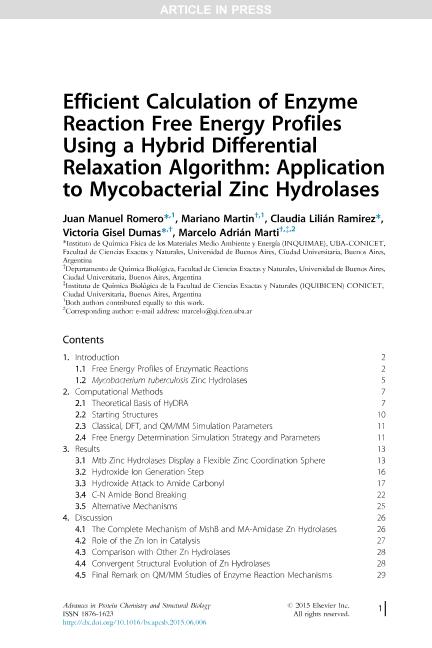Artículo
Efficient calculation of enzyme reaction free energy profiles using a hybrid differential relaxation algorithm: Application to mycobacterial zinc hydrolases
Romero, Juan Manuel ; Martin, Mariano; Ramírez, Claudia Lilián
; Martin, Mariano; Ramírez, Claudia Lilián ; Dumas, Victoria Gisel
; Dumas, Victoria Gisel ; Marti, Marcelo Adrian
; Marti, Marcelo Adrian
 ; Martin, Mariano; Ramírez, Claudia Lilián
; Martin, Mariano; Ramírez, Claudia Lilián ; Dumas, Victoria Gisel
; Dumas, Victoria Gisel ; Marti, Marcelo Adrian
; Marti, Marcelo Adrian
Fecha de publicación:
01/2015
Editorial:
Academic Press Inc.
Revista:
Advances in Protein Chemistry and Structural Biology
ISSN:
1876-1623
Idioma:
Inglés
Tipo de recurso:
Artículo publicado
Clasificación temática:
Resumen
Determination of the free energy profile for an enzyme reaction mechanism is of primordial relevance, paving the way for our understanding of the enzyme's catalytic power at the molecular level. Although hybrid, mostly DFT-based, QM/MM methods have been extensively applied to this type of studies, achieving accurate and statistically converged results at a moderate computational cost is still an open challenge. Recently, we have shown that accurate results can be achieved in less computational time, combining Jarzynski's relationship with a hybrid differential relaxation algorithm (HyDRA), which allows partial relaxation of the solvent during the nonequilibrium steering of the reaction. In this work, we have applied this strategy to study two mycobacterial zinc hydrolases. Mycobacterium tuberculosis infections are still a worldwide problem and thus characterization and validation of new drug targets is an intense field of research. Among possible drug targets, recently two essential zinc hydrolases, MshB (Rv1170) and MA-amidase (Rv3717), have been proposed and structurally characterized. Although possible mechanisms have been proposed by analogy to the widely studied human Zn hydrolases, several key issues, particularly those related to Zn coordination sphere and its role in catalysis, remained unanswered. Our results show that mycobacterial Zn hydrolases share a basic two-step mechanism. First, the attacking water becomes deprotonated by the conserved base and establishes the new C-O bond leading to a tetrahedral intermediate. The intermediate requires moderate reorganization to allow for proton transfer to the amide N and C-N bond breaking to occur in the second step. Zn ion plays a key role in stabilizing the tetrahedral intermediate and balancing the negative charge of the substrate during hydroxide ion attack. Finally, comparative analysis of other Zn hydrolases points to a convergent mechanistic evolution.
Archivos asociados
Licencia
Identificadores
Colecciones
Articulos(INQUIMAE)
Articulos de INST.D/QUIM FIS D/L MATERIALES MEDIOAMB Y ENERGIA
Articulos de INST.D/QUIM FIS D/L MATERIALES MEDIOAMB Y ENERGIA
Citación
Romero, Juan Manuel; Martin, Mariano; Ramírez, Claudia Lilián; Dumas, Victoria Gisel; Marti, Marcelo Adrian; Efficient calculation of enzyme reaction free energy profiles using a hybrid differential relaxation algorithm: Application to mycobacterial zinc hydrolases; Academic Press Inc.; Advances in Protein Chemistry and Structural Biology; 100; 1-2015; 33-65
Compartir
Altmétricas



